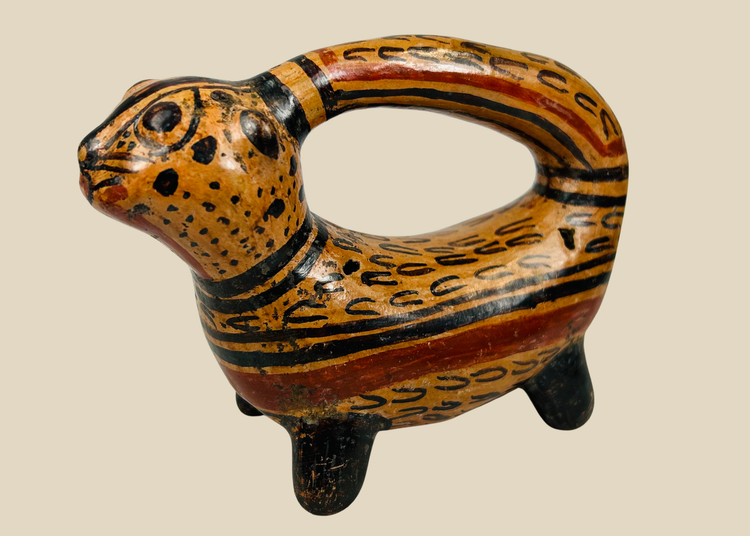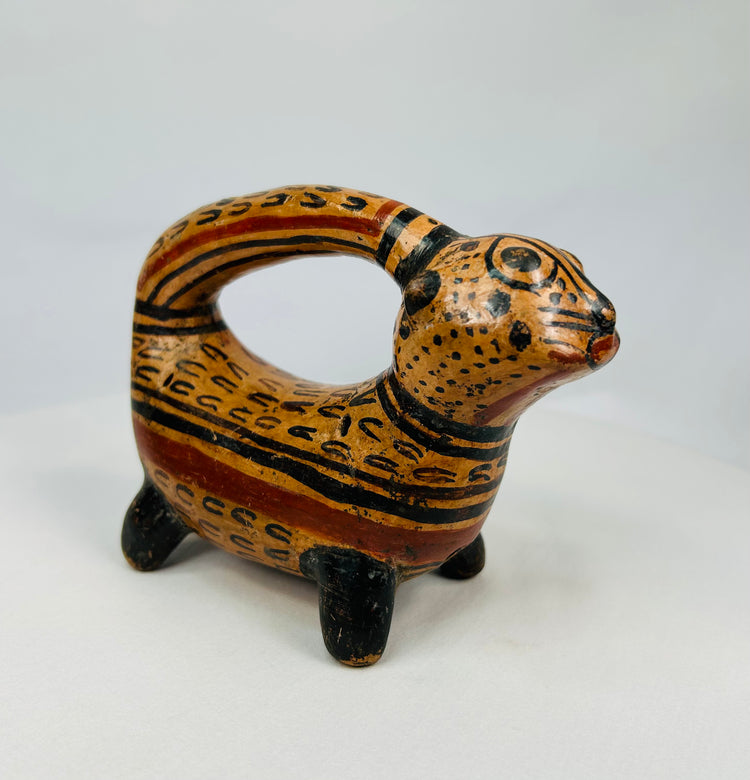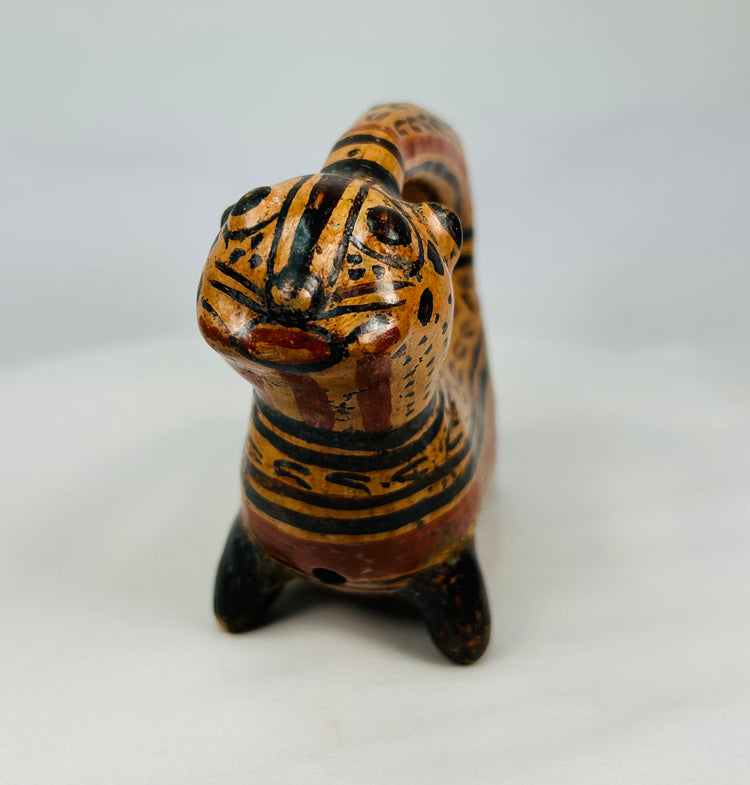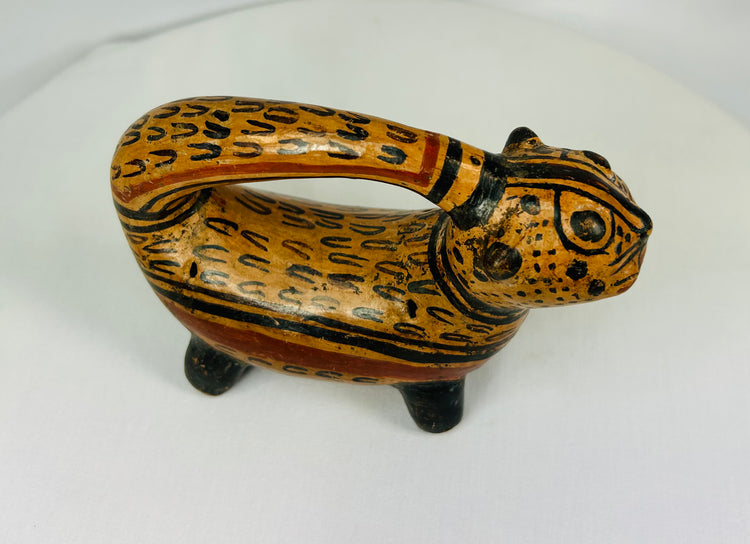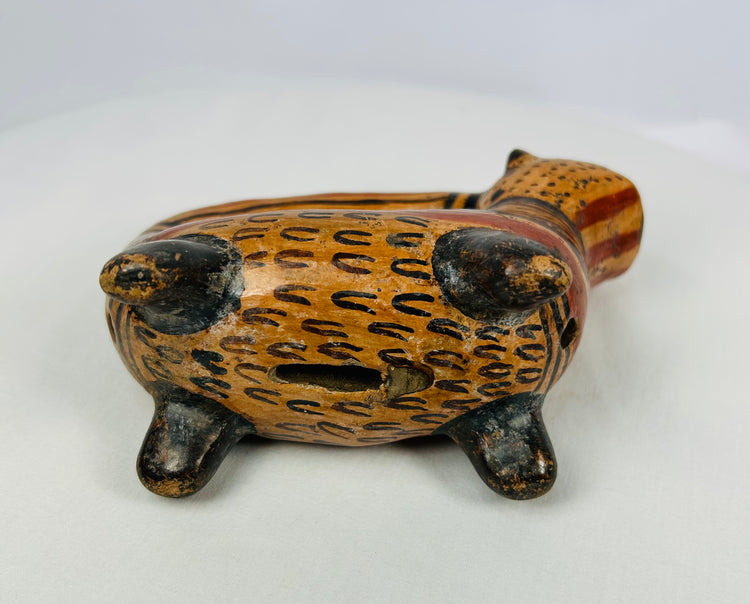Pre-Columbian | Jaguar Effigy Vessel | Guanacaste-Nicoya or Northern Peru | Circa 500–1200 CE
Description
More
Less
Historical Context & Origin
Region: Northwestern Costa Rica or Northern Peru
Material: Hand-painted terracotta with mineral pigments
Period: Circa 500–1200 CE
Description
This remarkable hand-modeled ceramic vessel, shaped in the stylized form of a feline—likely a jaguar, reflects the artistry and spiritual depth of ancient Central and South American civilizations. The vessel features a gracefully arched handle extending from head to rear and is decorated in vibrant red, black, and ochre slip pigments that highlight the creature’s musculature and movement.
The jaguar, a revered symbol of power, transformation, and the bridge between earthly and spiritual realms, is beautifully captured in this effigy. The hollow body includes a vent and spout aperture, indicating its use as a ceremonial whistle or ritual vessel, possibly for rites invoking fertility, transformation, or rain.
Features
- Hand-painted in red, black, and ochre mineral slips
- Stylized jaguar effigy with elegantly arched handle
- Distinct spotted and geometric banded decoration
- Functional vent and spout apertures suggesting ritual use
- Excellent preservation with traces of mineral deposits and age patina
Cultural Significance
In the Guanacaste-Nicoya region of Costa Rica and among early Northern Peruvian coastal cultures, the jaguar symbolized divine strength and the shamanic link between the natural and spiritual worlds. Vessels like this served both ceremonial and funerary purposes, offering spiritual protection and invoking transformation.
Condition
Minor surface wear and pigment fading consistent with age. Small abrasions and mineral accretions present, yet the structure remains stable and the original polychrome coloration remarkably preserved.
Dimensions (Approximate)
Length: 6 in
Width: 2.5 in
Height: 4.5 in
Age
Circa 500–1200 CE
Learn More & Explore
Discover a companion piece: Pre-Columbian Terracotta Vessel, 300–800 CE another remarkable ancient ceramic that complements this jaguar effigy in form and function.
Read more about similar artifacts at the Brooklyn Museum explore how ritual ceramics connected everyday life, faith, and transformation in early American civilizations.
Description
Historical Context & Origin
Region: Northwestern Costa Rica or Northern Peru
Material: Hand-painted terracotta with mineral pigments
Period: Circa 500–1200 CE
Description
This remarkable hand-modeled ceramic vessel, shaped in the stylized form of a feline—likely a jaguar, reflects the artistry and spiritual depth of ancient Central and South American civilizations. The vessel features a gracefully arched handle extending from head to rear and is decorated in vibrant red, black, and ochre slip pigments that highlight the creature’s musculature and movement.
The jaguar, a revered symbol of power, transformation, and the bridge between earthly and spiritual realms, is beautifully captured in this effigy. The hollow body includes a vent and spout aperture, indicating its use as a ceremonial whistle or ritual vessel, possibly for rites invoking fertility, transformation, or rain.
Features
- Hand-painted in red, black, and ochre mineral slips
- Stylized jaguar effigy with elegantly arched handle
- Distinct spotted and geometric banded decoration
- Functional vent and spout apertures suggesting ritual use
- Excellent preservation with traces of mineral deposits and age patina
Cultural Significance
In the Guanacaste-Nicoya region of Costa Rica and among early Northern Peruvian coastal cultures, the jaguar symbolized divine strength and the shamanic link between the natural and spiritual worlds. Vessels like this served both ceremonial and funerary purposes, offering spiritual protection and invoking transformation.
Condition
Minor surface wear and pigment fading consistent with age. Small abrasions and mineral accretions present, yet the structure remains stable and the original polychrome coloration remarkably preserved.
Dimensions (Approximate)
Length: 6 in
Width: 2.5 in
Height: 4.5 in
Age
Circa 500–1200 CE
Learn More & Explore
Discover a companion piece: Pre-Columbian Terracotta Vessel, 300–800 CE another remarkable ancient ceramic that complements this jaguar effigy in form and function.
Read more about similar artifacts at the Brooklyn Museum explore how ritual ceramics connected everyday life, faith, and transformation in early American civilizations.
You May Also Like




















